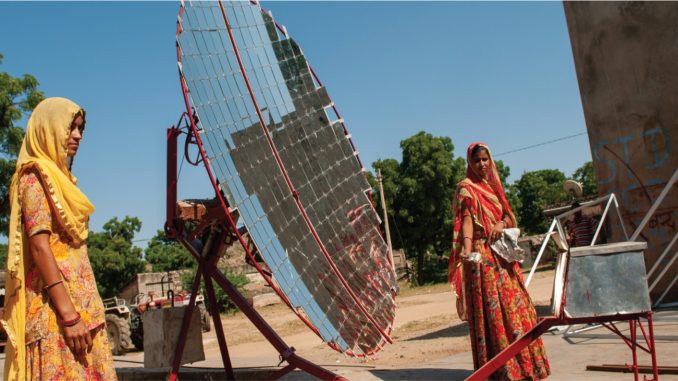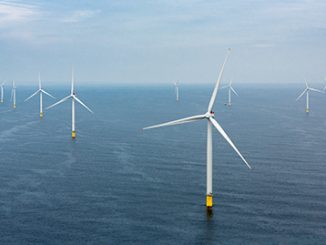
By Kasvi Singh
Renewable energy is often termed as the “change enabler” for sustainability goals. However, if such a change is not equitable, then the battle is only half won. Globally, countries are rapidly moving towards renewable energy transition, motivated by their ambitious emission targets and energy portfolio goals. India, too, has set a massive target of net zero emissions by 2070. Renewable energy is expected to play a leading role in achieving the country’s development goals over the current decade. However, it is imperative that such an energy transition be gender inclusive to bring in the transformational shift required to achieve the desired clean energy targets. While at present the renewable energy sector employs a greater percentage of women as compared to fossil fuel-based energy industries, the scope for increasing the role of women in the renewable industry is still enormous.
Women can engage with renewable energy, both as entrepreneurs/employees in the value chain and as end-users. Several studies have established that energy poverty has a strong gender dimension to it. While access to clean energy is integral to improving anyone’s standard of living, its absence poses a greater obstacle for women and girls. Lack of clean energy can have severe implications for the economic and personal well-being of women. The opportunity cost of the greater amount of time they end up spending on household chores translates into neglect of education and income-generating opportunities. Societal perceptions, renewable energy policies and labour market patterns may exacerbate such gender inequalities. Renewable energy access has the potential to curb such limitations, allowing women to utilise their time more effectively, while improving their physical and financial well-being. However, while the focus has so far primarily been on what clean energy access can do for women as end-users, it is now important to shift the narrative towards what women can do for the growth and expansion of clean energy.
Currently, the presence of women in the sector is primarily limited to administrative roles. The International Energy Agency states that operation- and field-based roles engage a significantly lower/almost negligible number of women due to concerns regarding the safety of the project locations and inherent prejudices regarding women’s ability to perform such roles. Even at the decision-making level, the participation of women is not on a par with that of men. Thus, despite the various possibilities that the renewable energy sector presents for engaging women, they continue to be underrepresented. Renewable energy and women can have a synergistic relationship wherein the former improves livelihood prospects for women and in turn women boost the growth of the sector by providing expertise in various domains. With focused training and skill development, the women workforce can play an increasingly crucial role in achieving India’s clean energy target of 450 GW by 2030.
Women and clean energy
Women can play diverse roles in the clean energy industry. These roles can be broadly classified into four categories: entrepreneurs producing/providing renewable energy solutions; employees/labour across the value chain; owners of microenterprises that depend on utilising clean energy for their operations; and end-users of renewable energy for household and personal utility. The International Renewable Energy Agency has reported that women hold 32 per cent of renewable energy jobs at present vis-à-vis 22 per cent in the fossil fuel industry. The agency highlights that there is a need for more women in the renewable energy sector. Science-, technology-, engineering- and maths (STEM)-based jobs particularly showcase a steep dearth of women.
As per the World Bank database, the female labour participation rate in India fell to 20.3 per cent in 2019, well below the world average of 47 per cent. The Covid-19 pandemic is likely to have negatively impacted this further, with a larger burden of household chores and responsibilities falling upon women. The booming renewable energy industry can help negate such effects by providing women diverse opportunities for work. Engaging women in the clean energy transition of the country can bring in diverse talent in the clean energy movement. Women can contribute valuable perspectives at all stages of the value chain, starting from the field to the decision-making level. Women also have varied social networks, which can help bring clean energy access to a larger network of people. Since many renewable energy jobs employ unskilled and semi-skilled workers, they could provide viable alternatives to women who are not trained enough to work in the formal economy.
For women as end-users, at home and in microenterprises, clean energy access can prove to be a time-saving mechanism. For instance, using clean energy for cooking saves the time spent on collecting firewood and reduces exposure to polluting fumes. The time saved can be devoted to activities such as education and training, which can equip women with the skills to participate in the formal economy. A number of studies have gathered that clean energy access can improve the chances for girls to complete primary education and for women to earn higher wages. Microenterprises can also improve output, with reliable clean energy access. Furthermore, as many women are engaged in the agricultural sector, technologies such as solar pumps can play a crucial role in improving efficiency in irrigation and pumping water, preventing women from walking long distances to waterbodies. In recent times, the share of both men and women in the agricultural workforce has declined. While men have been able to find employment elsewhere, this is not true for women. The renewable energy sector can fill this gap by providing women employment opportunities at different levels of proficiency. However, deep-rooted societal biases, the historical division of gender roles, lack of access to large funds and the limited availability of financial securities such as collateral for women are key barriers that need to be addressed.
Small steps
On the bright side, steps are already being taken to develop a greater role for women in the clean energy industry. For instance, the Pollinate Group is an organisation that identifies and trains women as agents of change who sell off-grid solar solutions across communities in India and Nepal. So far, the initiative has empowered over 800 women to bring clean energy access to over 668,000 people living on less than $1.9 a day in India and Nepal, while saving over $23 million and over 60,000 tonnes of CO2 emissions. Another story highlighting the importance of women in the industry is that of Gurmet Angmo, a solar engineer working with the Global Himalayan Expedition. Gurmet has contributed to the electrification of over 50 villages in Ladakh and Meghalaya with solar power. Similar developments have also been witnessed in states such as Odisha, where women have been employed as “bijulee didis” to enhance the customer services of electricity suppliers and improve energy access in remote villages.
In February 2022, the United Nations Environment Programme joined hands with ReNew Power and non-government organisations (NGOs) to train women from the informal sector in Gujarat to work in the modern clean energy industry. Initially, the women to be trained under the programme will include salt pan workers from the Rann of Kutch, who will be trained as solar panel and solar pump technicians. To begin with, 1,000 women will be trained across the Self-Employed Women’s Association training centres and ReNew Power’s facilities in Gujarat. The technical training will be provided by another NGO, the Electronics Sector Skills Council of India. Upon success, the training programme is likely to be replicated in other parts of the country over the coming years. The programme is a great way to bring access to and awareness regarding clean energy to rural and far-flung areas, which can help the workforce advance from traditional energy sources to the clean energy industry. While such steps are being taken and could prove to be useful in empowering women and providing them greater financial and livelihood opportunities, these efforts are currently scattered. A focused plan of action directed towards engendering gender equity in the renewable energy industry would go a long way in bringing about a just energy transition in the country.
The way ahead
The renewable energy sector is multidimensional, with wide-ranging impacts on employment generation, women empowerment, human health and energy security. Analysing the success of a renewable energy project is currently limited to aspects such as reduction of emissions and operational costs. However, diverse factors such as the level of gender inclusivity, both from the demand and supply ends, should also be increasingly viewed as a measure for analysing a renewable energy project. There exists an integral nexus between energy, water, agriculture, microenterprises and gender equity. Renewable energy is likely to become the backbone of this nexus. Policies must aim at mainstreaming the role of women across the value chain, while provisions for training, skill development, awareness and financial access for women entrepreneurs directly or indirectly engaged in the sector should also be made. Factors such as ownership of land must be considered when evaluating the benefits of a renewable energy project. For instance, as land is mostly owned by male members of the family, financial benefits from a solar plant on private land may not get extended to women. Thus, recognising the existing gender gap in the sector and taking conscious industry-led action to form a synergistic partnership between women and renewable energy is the inevitable path towards solving gender inequities, from the field to the boardroom.



